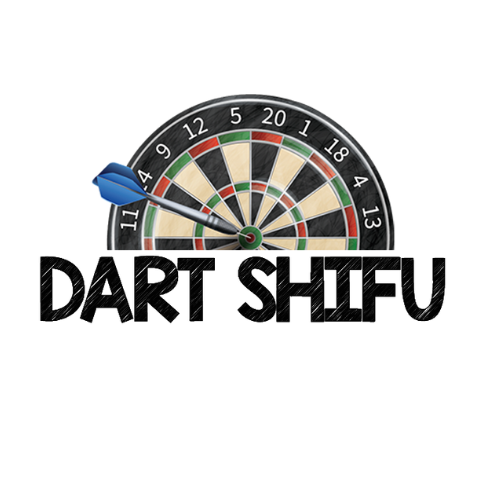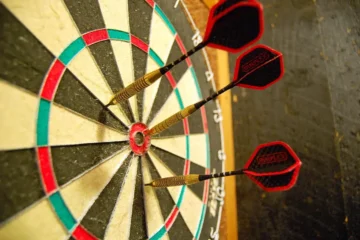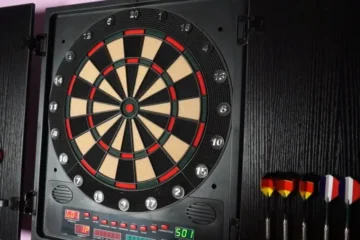Do you love cricket and darts? Cricket and darts are two popular games, but have you ever thought of combining them? Cricket darts is an exciting game that involves throwing darts at a board to score points, but with a twist
In this article, we’ll guide you through the rules of cricket darts and give you helpful tips to improve your game. From aiming your darts to strategizing your throws, we’ve got you covered. Plus, we’ll include insights from renowned darts experts and players to help you hone your skills.
So, whether you’re a cricket fan or a darts enthusiast, cricket darts are a fun and challenging game for players of all skill levels. Follow our guide and see how your skills stack up against the competition!
Setting Up the Game
In cricket darts, the goal is to score points by hitting certain numbers on the dartboard and to “close out” those numbers before your opponent does. The game can be played in singles or doubles format and can be a great way to socialize and have fun with friends or family.
Dartboard set-up
To set up a cricket darts game, you will need a standard dartboard that has numbered sections ranging from 1 to 20, as well as a bullseye in the center. The dartboard should be hung at a height of 5 feet 8 inches (1.73 meters) from the ground and should be positioned so that the bullseye is exactly 5 feet 8 inches (1.73 meters) from the floor.
The throw line, also known as the “oche,” should be marked on the floor and be positioned 7 feet 9 1/4 inches (2.37 meters) from the front of the dartboard.
Number of players
Cricket darts can be played with either two players (singles) or four players (doubles). In singles play, each player takes turns throwing three darts per turn. In doubles play, two teams of two players each takes turns to throw three darts per turn. The order of play can be determined by a coin toss or by each player throwing one dart to see who gets closest to the bullseye.
Scoring system
In cricket darts, the numbers 20, 19, 18, 17, 16, 15, and the bullseye are the focus of the game. The objective is to score as many points as possible by hitting these numbers and to “close them out” by hitting each number three times.
The points scored for each hit are the value of the number hit (for example, hitting the 20 scores of 20 points). Once a player has hit a number three times, that number is considered “closed” and the player can score points by hitting it again, while their opponent cannot.
Equipment required
To play cricket darts, you will need a standard dartboard, a set of three darts per player, and a well-lit playing area. The darts should be of good quality and should have a comfortable grip that suits the player’s throwing style.
It’s important to ensure that the dartboard is hung securely and that the darts are thrown with care to avoid any damage to the dartboard or the surrounding area.
How to Play Cricket Darts
The objective is to score points by hitting certain numbers on the dartboard and to “close out” those numbers before your opponent does. The game can be played in singles or doubles format, and the winner is the player or team that scores the most points by the end of the game.
The object of the game
The object of cricket darts is to score points by hitting certain numbers on the dartboard and to “close out” those numbers before your opponent does. The numbers 20, 19, 18, 17, 16, 15, and the bullseye are the focus of the game. The first player or team to close out all of these numbers and have the highest score at the end of the game wins.
Starting the game
To start the game, players or teams take turns throwing one dart at the bullseye. The player or team that gets closest to the bullseye goes first. The first player then throws three darts at the dartboard, aiming to hit the numbers 20, 19, 18, 17, 16, 15, and the bullseye.
Scoring
In cricket darts, the points scored for each hit are the value of the number hit. For example, hitting 20 scores and 20 points. Once a player has hit a number three times, that number is considered “closed” and the player can score points by hitting it again, while their opponent cannot. The player with the most points at the end of the game wins.
Closing out numbers
To close out a number, a player must hit that number three times. Once a player has closed out a number, they can score points by hitting it again, while their opponent cannot. The bullseye can also be closed out by hitting it twice – the outer bullseye counts for 25 points and the inner bullseye counts for 50 points.
Winning the game
The winner of cricket darts is the player or team that scores the most points by the end of the game. To win, a player must close out all of the numbers and have the highest score at the end of the game. If both players or teams have closed out all of the numbers, the player or team with the highest score wins. If there is a tie, a tiebreaker round can be played to determine the winner.
Strategies and Tips for Cricket Darts
Whether you’re a beginner or a seasoned player, understanding the best ways to approach the game, practicing key techniques, and avoiding common mistakes can help improve your performance and increase your chances of winning.
Best way to approach the game
One of the best ways to approach the game is to focus on closing out numbers as quickly as possible while preventing your opponent from doing the same. This means prioritizing hitting the numbers 20, 19, 18, 17, 16, and 15, in that order.
Additionally, it’s important to aim for the bullseye whenever possible, as this can help increase your score and ultimately lead to a win. Finally, try to maintain consistency in your throwing technique and avoid getting frustrated if you miss a shot.
Practice techniques
Practicing key techniques can help improve your performance in cricket darts. One technique is to focus on your aim and try to hit specific targets consistently. Another technique is to develop a consistent throwing motion and work on releasing the dart at the same point each time.
Additionally, practicing different types of throws, such as underarm or overarm, can help you find a style that works best for you.
Common mistakes to avoid
There are several common mistakes that players often make in cricket darts. One is failing to prioritize the correct numbers or focusing too much on the bullseye. Another is getting frustrated or giving up too easily after missing a shot. It’s important to stay focused and maintain a positive attitude throughout the game.
Finally, avoid changing your throwing technique or grip mid-game, as this can disrupt your consistency and accuracy.
Cricket Variations
Cut Throat
In Cut Throat cricket, players try to knock out their opponents’ numbers, and the player with the most remaining numbers at the end of the game wins. The twist is that any time a player hits a number that has already been closed out by another player, that number is re-opened. This variation requires players to keep track of their numbers while also keeping an eye on their opponents’ progress, making for a more strategic and competitive game.
Double Bull
In Double Bull cricket, players must hit the double bullseye to score points. This variation adds an extra layer of challenge, as hitting the small inner bullseye is more difficult than hitting the outer bullseye or other numbered segments. Double Bull cricket requires precise aim and control and can be a great way for experienced players to test their skills.
Lowball
Lowball cricket is the opposite of traditional cricket in that the lowest score wins instead of the highest. Players aim to hit the numbers 20, 19, 18, 17, 16, 15, and the outer bullseye, but the goal is to score as few points as possible. This variation requires players to rethink their strategy and focus on hitting the lower numbers instead of the higher ones, adding a new level of challenge to the game.
No Score
In No Score cricket, hitting a number does not score any points. Instead, players must hit each number three times to close it out, just like in traditional cricket. This variation requires players to be more accurate and consistent in their throws, as hitting a number only counts toward closing it out and not toward scoring points. No Score cricket can be a great way to practice precision and consistency in darts.
Double Only
In Double Only cricket, players can only score points by hitting the double segments of each number. This variation requires even more precision and accuracy, as hitting a single segment of a number does not score any points. Double Only cricket can be a great way for experienced players to challenge themselves and push their skills to the limit.
Round-the-Clock Cricket
This variation of Cricket darts involves hitting each number on the board in numerical order, starting from 1 and ending at 20. Players must hit each number three times before moving on to the next. The bullseye can be used as a wild card if a player is having trouble hitting a particular number.
Elimination Cricket
In this variation, players take turns throwing one dart at the board. The player with the lowest score is eliminated after each round until only one player remains. The remaining player is the winner.
Random Cricket
In this variation, a random number is chosen before each turn and must be hit by the player. Players can still score points on other numbers, but the chosen number must be hit to advance.
Half-It Cricket
This variation involves each player taking turns throwing one dart at the board. The number hit is then multiplied by two and added to the player’s score. If the player hits a triple, their score is tripled instead. If the player hits a double, they can choose to add it to their score or subtract it from their opponent’s score. The first player to reach a predetermined score (usually 51 or 101) wins.
High Score Cricket
In this variation, players are trying to achieve the highest score possible by hitting the highest numbers on the board. Each player gets three darts per turn and the highest number hit is added to their total score. The first player to reach a predetermined score (usually 300 or 500) wins.
Low Score Cricket
In this variation, players are trying to achieve the lowest score possible by hitting the lowest numbers on the board. Each player gets three darts per turn and the lowest number hit is subtracted from their total score. The first player to reach a predetermined score (usually -50 or -100) wins.
FAQ
What is the object of the game of Cricket darts?
The object of the game is to score points by hitting the numbers 20, 19, 18, 17, 16, 15, and the bullseye before your opponent does. Once a player has hit a number three times, that number is considered “closed” for that player and they can start scoring points for it.
How many players can play Cricket darts?
Cricket darts can be played with two or more players. However, it is usually played with two players or teams of two.
Can you still score points on a number that has been closed out?
No, once a number has been closed out by a player or team, it can no longer be scored on by either player or team.
What happens if a player hits a number they have already closed out?
If a player hits a number they have already closed out, they do not score any additional points. However, if their opponent has not yet closed out that number, their opponent can still score points on it.
What is the best way to improve at Cricket darts?
The best way to improve at Cricket darts is to practice regularly and focus on accuracy and consistency in your throws. Additionally, studying different strategies and techniques can also improve your game.
Final thoughts
Whether you’re a beginner or a seasoned player. It’s a fun game that can be enjoyed by all and a great way to challenge yourself to improve your darts skills. Practice and consistency are key to improving your cricket darts game. Experiment with different techniques and grips, and most importantly, have fun with the game! Whether you’re playing competitively or just for fun, cricket darts are a great way to spend time with loved ones and hone your skills.


